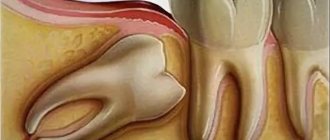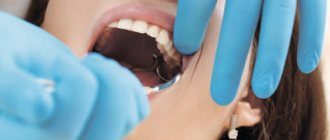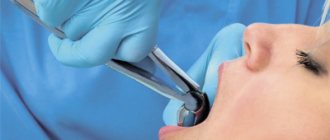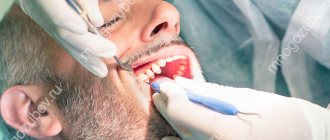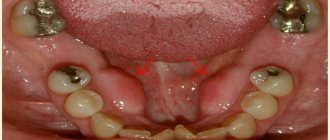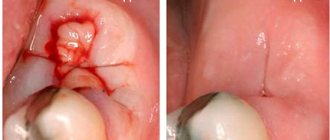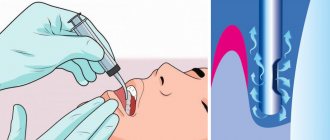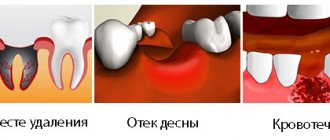Usually, the healing of the hole after tooth extraction occurs painlessly and does not cause any sensations in the patient. It would be good if everyone knew how this process works and how to speed it up.
Proper oral care after tooth extraction and following all the dentist’s recommendations will help speed up the healing of the hole and avoid complications.
Content:
- Why does a wound take a long time to heal after tooth extraction?
- How gums heal normally
- Gum healing time
- How to speed up gum healing after tooth extraction
- What complications can tooth extraction cause?
Healing after tooth extraction can proceed quickly or take a long time. The second option is extremely undesirable and dangerous to the patient’s health. Therefore, it is important for the patient to know how long the regeneration process takes, what symptoms indicate a secondary infection, and how recovery can be accelerated.
Prevention measures
Naturally, it is necessary to consult a doctor in a timely manner and begin treatment, since the inflammatory process can lead to serious consequences. For preventive purposes, you must remember the following:
- Tooth extraction operations should only be performed by a trusted, experienced specialist who works specifically in the field of surgery;
- Follow all doctor’s recommendations for treatment and recovery exactly to avoid negative consequences;
- Undergo complex treatment without completing it in advance because you feel well. Interruption of therapy until complete recovery can cause an aggravation of health, lead to the formation of bacteria and a new inflammatory process.
With proper treatment and no complications, the problem is cured within a few days.
The patient must remain in bed for several days to fully recover. Minor pain in the area of the extracted tooth may periodically bother you for 3 weeks, but it will be less intense and will gradually go away. Remember, it is important to consult a doctor in a timely manner and undergo comprehensive treatment so as not to bring your health to a critical point. This article is for informational purposes only, please consult your doctor for details! Ask your doctor about contraindications and side effects.
Why does a wound take a long time to heal after tooth extraction?
Ripping out a destroyed unit is a very traumatic process. This operation is comparable to any other surgical procedure. The tissue surrounding the removed roots is severely damaged. The integrity of the periodontal and periodontal zones is compromised.
Microtears of ligaments and destruction of individual nerve bundles are observed. The injured area swells, turns blue, swells, and becomes painful to the touch. It is clear that in such a situation regeneration cannot be lightning fast. It should be understood that how long it takes for gums to recover depends on many factors:
- person's age;
- an illness that necessitated dental surgery;
- characteristics of the patient's health status;
- the presence of concomitant pathologies of a systemic nature in the patient;
- the complexity of the surgical procedures being performed;
- experience of a dental surgeon;
- the need for sutures;
- the number of roots in the tooth being pulled out;
- features of the location of the unit in the dentition.
Tooth granuloma: symptoms
The diagnosis of “apical granuloma of the tooth” can only be made by an x-ray, on which a slight rounded darkening will be visible at the apex of the tooth root (Fig. 1). Darkening at the apex of the tooth root on an x-ray always indicates the presence of a chronic focus of inflammation and the presence of bone tissue resorption. As for the patient's complaints and other symptoms, in most cases they are not pronounced or may even be absent.
Most of the time, the tooth may not bother you at all, or periodically there may be pain when biting on the tooth or aching pain from hot foods. Those. These symptoms are standard symptoms of chronic apical periodontitis, one of the forms of which is tooth root granuloma. However, periodically (during periods of decreased immunity) an exacerbation of chronic, low-grade inflammation may occur.
An exacerbation is usually accompanied by acute pain, especially pronounced when biting on a tooth. In addition, the gums in the projection of the root apex may swell at such moments and be painful when touched. An exacerbation of the process may spontaneously subside (return to a chronic course), but can also lead to the development of severe purulent inflammation, which is popularly called gumboil. Regardless of the outcome of acute inflammation, you will ultimately need the help of a dentist to save your tooth.
What does a granuloma look like on the root of an extracted tooth (video) –
How gums heal normally
Very often, patients ask the doctor how long it takes for the gums to heal after tooth extraction. They want to know how quickly they can return to their normal lifestyle. The rehabilitation process is quite long. It proceeds through several successive stages:
- Stop bleeding. Takes up to three hours. As soon as the blood stops flowing, a scarlet clot forms. It prevents bacteria, viruses and microbes from penetrating deep tissues.
- The appearance of a white connective film. This is epithelial tissue. It can be seen four days after removal.
- The clot acquires a white color. Occurs approximately one week after surgery.
- Replacement of a blood clot with full-fledged epithelial tissue. It is fixed approximately 20-24 days after tooth extraction. This indicates that regeneration was successful.
As a rule, less than a month after tooth extraction, the patient is completely healthy, feels well and does not experience any discomfort while eating. If the number of roots pulled out was small, then regeneration can be completed in two to three weeks.
Granuloma on the root of the tooth - causes of appearance
There are only 2 main reasons for the occurrence of granulomas at the apexes of tooth roots. These reasons occur in 98% of cases, and we have described them in detail below. Much less often, granulomas are formed as a result of poor-quality orthodontic treatment, or mechanical trauma to the tooth (after an impact).
- As a consequence of untreated pulpitis (Fig. 4) - when the carious cavity of the tooth becomes deep enough - cariogenic microorganisms penetrate into the dental pulp, causing inflammation in it (it is called pulpitis). This is accompanied by sharp or aching pain. If the tooth is not treated at this stage, the nerve in the tooth dies and the pain temporarily stops.
After the death of the nerve, pathogenic microorganisms penetrate through the root canals and openings at the apex of the roots - beyond the boundaries of the tooth. This leads to the formation of foci of inflammation at the apexes of the roots (24stoma.ru). This disease is called periodontitis. There are several types of this disease, in one of which granulomas form at the tops of the roots.Keep in mind that in this case the tooth does not necessarily have to have a carious cavity, because Inflammation of the nerve in a tooth can also occur in a tooth previously treated for caries. This happens if the doctor has not completely removed the tissue affected by caries, leaving a small fragment of it under the filling (Fig. 5). In this case, caries develops under the filling and leads to the development of first pulpitis, and then periodontitis with granuloma.
- Poor-quality root canal filling - if a granuloma has formed on the root of a tooth in which root canals were previously filled (for example, during the treatment of pulpitis), then there is only one reason for its formation!
This reason is poor-quality filling of the canals, or more precisely, the fact that the root canals were not filled to the apex of the root (Fig. 6). If your doctor says that the canals are sealed well, and he does not know why a granuloma appeared after treatment, then such a doctor is lying. “The tooth is filled well, take antibiotics” - this is a standard excuse from doctors who do not want to admit to poor-quality work and, at the same time, treat the tooth for free.
Gum healing time
Conventionally, dentists divide the regeneration process into two stages - partial, complete. Partial epithelization is said to occur in the first 12 days after tearing out, and complete epithelialization occurs after 20-25 days. But with complex removal, leading to significant damage to bone tissue and muscles, the recovery period may increase by several more days.
Among the most common reasons causing slow epithelization:
- significant trauma to bone tissue and gums during the intervention (especially if the bone around the diseased tooth was cut out with a drill);
- the occurrence of alveolitis of the inflamed socket;
- damage to the protective clot or its unformation (“dry” hole);
- incomplete removal of bone fragments due to the doctor’s carelessness;
- mobility of the mucous membranes, which needed to be sutured, but for some reason the surgeon decided not to suture;
- refusal to use antibiotics during a severe recovery period;
- diabetes;
- reduced immunity.
How to rinse your mouth after a gum incision
Rinsing the mouth after surgery is not done immediately, so as not to wash out the blood clot from the wound.
They use pharmaceutical products: chemical and herbal, as well as those prepared at home.
| Ready-made products | Home Remedies | |
| Chemical | On herbs | |
| Chlorhexidine | Stomatophyte | Infusions: · sage; · chamomile; · oak bark; · calendula; take 1 tbsp. for 1 tbsp. boiling water, leave for 15–30 minutes, strain, cool, add to a volume of 200 ml |
| Miramistin | Maraslavin | Saline or soda-salt solution (1 teaspoon each of soda and salt, preferably sea salt, per 1 cup of water) |
| Furacillin | Rotokan | Light pink solution of potassium permanganate |
In addition to general recommendations, the doctor will advise what to rinse the mouth of a particular patient.
You need to rinse after each meal until swelling and pain disappear. Sometimes the same products are used for applications and lotions on the incision area.
How to speed up gum healing after tooth extraction
The simplest and most effective technique that a dental surgeon can use to ensure fast and effective regeneration is suturing the socket. It is important to ensure that the edges of the mucous membranes are located as close to each other as possible. This will reduce the risk of secondary infection and create suitable conditions for trouble-free regeneration.
It is also very important that the patient strictly followed all medical prescriptions. The pharmacy offers a wide range of healing and anti-inflammatory ointments, gels, creams and solutions used in dentistry. But you don’t need to buy the first product that comes your way—the drug must be prescribed by a doctor.
It is very important not to touch the healing hole with your tongue or foreign objects. It is forbidden to touch the blood clot covering the wound. If you move it from its place, severe inflammation may occur. Then it will most likely not be possible to do without antibiotics.
Recommendations for oral care after surgery
After applying stitches, you must follow a number of rules:
- Do not pick at the wound again, do not touch it with your hands or tongue
- Don't eat too fatty foods
- It is better to give up solid foods - apples, nuts, seeds
- Do not try to remove stitches yourself
- Rinse your mouth with Rotokan solution and other means prescribed by your doctor.
- It is recommended to brush your teeth with a new toothbrush
- It is not recommended to use dental floss near the suture site.
- Don't drink alcohol
- Do not use medications that thin the blood
- Do not drink coloring or too hot drinks - coffee, black tea, lemonade, soda
- Do not try to stop the bleeding if intense bleeding occurs using self-prescribed medications. It is better to go to a 24-hour dental clinic or call a doctor at home.
What complications can tooth extraction lead to?
Normally, restoration of injured tissue occurs within three weeks. The red, inflamed gum gradually acquires a pale pink color and ceases to be painful on palpation. But if a person has diseases that prevent rapid recovery, or he does not comply with doctor’s orders, then the rehabilitation process can be difficult. Then the patient will face complications, including:
- hematoma;
- severe swelling of the soft tissues of the cheek;
- frequent bleeding from the wound;
- numbness of the tongue, cheeks, lips;
- pain while eating.
If the healing of the hole is in doubt - a person thinks that something is going wrong - he should immediately consult a doctor. The doctor will conduct an examination and tell you whether you need to use any drugs to speed up regeneration.
Therapeutic treatment
Treatment is carried out according to a standard scheme and it is important to start it in a timely manner:
- Cleaning the hole from food debris, plaque, and dead tissue;
- A thorough inspection of the hole, checking for the absence of roots and foreign elements;
- Washing the wound with hydrogen peroxide;
- Drying the wound;
- Putting anti-inflammatory drugs into the hole.
After treatment, the doctor gives recommendations to the patient on oral care. A few days later, the patient comes back for an examination to make sure that the treatment has given positive results and the wound is healing. It is important to rinse your mouth with herbal decoctions at home. Do not eat hard foods. For pain relief, you can use Nimesil or Ketanov.
